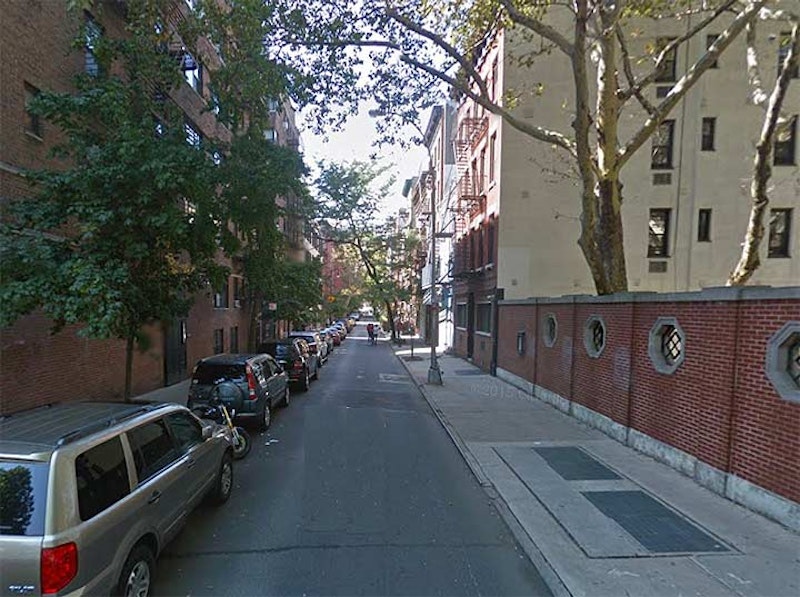Many more years ago than I’d like to say here, I had a short-lived job at a print shop on Greenwich Street in the far West Village. I would take the train to West 4th and make my way southwest in the maze of Village streets to Greenwich between Charlton and Spring. As it happens there was one street that was the most convenient and I would use it more than any other street: Downing.
It’s one of the Village’s obscurer routes. It’s not in the Greenwich Village Historic District so there’s not much online about it—if a street is in a Landmarked district, the city posts PDFs describing every building on every street in the honored district.
But the wisdom of Yogi is pervasive. “You can observe a lot by watching.” And, a cursory look at Downing Street will reveal much. Downing Street is narrow even by Village standards, and several buildings on the street possess very wide entrances.

On this 1909 Bromley atlas plate of Downing Street notice several dwellings lining the street that are marked with X’s. In the legend, an X means a stable or garage. Thus we can determine that Downing Street once served in large part as a place to stable horses. Carmine Street, one block north, is quite wide and Downing Street likely served the businesses and homes there.
On the right side of the map is a street that no longer exists; Hancock Street was absorbed by 6th Avenue when it was extended south when the IND subway was built along it in 1928.

The construction of 6th Avenue created some odd-shaped spaces. Churchill Square, named for British Prime Minister Winston Churchill (his mother Jennie was born in Brooklyn, and his grandfather Leonard Jerome was a successful stock speculator, railroad builder, and sportsman who built the Jerome Park Racetrack, later Jerome Park Reservoir, and was the namesake of The Bronx’ Jerome Avenue).
The naming of Manhattan’s Downing Street has been speculated about by historians for many years. Some say both Bedford and Downing Streets are named for the ones in London, but those streets don’t intersect in London, though they are both in the Trafalgar Square area.
London’s Downing Street, where #10 is the Prime Minister’s residence (hence Churchill Square) was named for Sir George Downing, who changed political affiliations like the rest of us change shirts. He was one of Harvard’s first nine graduates in 1642. He returned to England and joined up with Oliver Cromwell in his overthrow of the Crown, becoming minister to The Hague and France. After Cromwell’s death he joined the Royalists, and Charles II returned him to The Hague, representing England again; along the way he betrayed a friend who was a colonel in Cromwell’s forces, sending the friend to the executioner.
Downing was Britain’s envoy to the Netherlands in 1674 when “New Orange” or New Amsterdam was handed over to the British (this time for good) in exchange for Surinam. A tenuous connection, but perhaps a real one.

A six-story apartment building on the NE corner of Bedford and Downing Streets. In the early 20th century, even apartment houses built for the “working class” bore many touches of what I call casual elegance, and this building’s window lintels, roof corbelling, and corner quoins are still in place.
The city has installed retro versions of Type F lampposts, which, in smaller versions, once lit most of Manhattan’s side streets and were variations on the Bishop Crook theme. These new versions are taller with bases that match the heavier, long-armed "Corvingtons" which were used to illuminate wider streets.

#45’s status as a former garage, and a stable earlier on, is confirmed by the words “Tassi Garage” found just under the roofline.

Similarly, #49’s old stable status is marked by ole Dobbin grinning above the arched doorway.
Robert Moses’ battles against author/activist Jane Jacobs and others to place a roadway through Washington Square and build the Lower Manhattan Expressway are well-publicized. Less so was his plan to destroy or at least severely compromise Downing Street. At one time, the traffic czar wanted to build a new Verrazano Street between the intersection of West Houston and 6th Avenues west to Varick in order to accept traffic from the wide and busy Houston. This would have meant a lot of demolitions on Downing.
Verrazano St. would also have been a feeder road toward the proposed Lower Manhattan Expressway. The project actually got under way in 1962 when the city began buying property and condemning buildings along the proposed route. However, “LOMEX” was eventually killed by community opposition, and so was Verrazano Street.
—Kevin Walsh is the webmaster of the award-winning website Forgotten NY, and the author of the books Forgotten New York and also, with the Greater Astoria Historical Society, Forgotten Queens.

